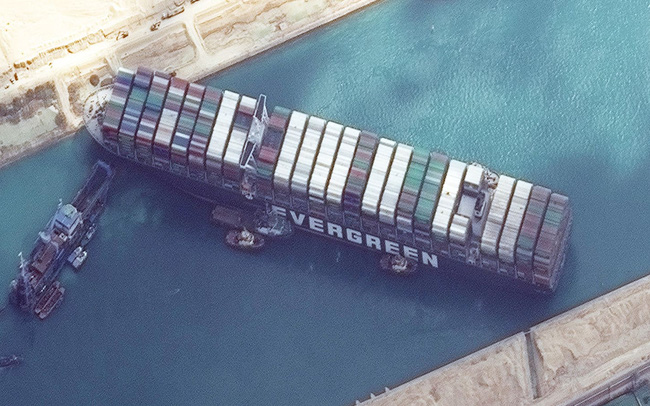An attempt to rescue the ship stranded on the Suez Canal failed again, and the economic impact began to spread
- Tram Ho

On March 26, White House Press Secretary Jen Psaki said the US was closely monitoring the situation. “We have asked the US to assist the Egyptian authorities in resolving the congestion in the Suez Canal. Discussions on this are ongoing,” she added. In addition, Ms. Psaki also said that the energy market is likely to be affected.
Oil prices soared yesterday, with predictions suggesting that an attempt to rescue the ship could take weeks. WTI and Brent crude oil futures were up more than 4%, after falling significantly the previous day.
“Traders are changing their minds,” said Paola Rodriguez-Masiu, vice president of oil markets at Rystad Energy. trade of oil and the transportation of supplies far more than they had previously forecast. ”

An aerial shot of the Ever Given boat ran aground at the Suez Canal.
Of the 39.2 million barrels of crude oil imported per day by sea in 2020, 1.74 million barrels pass through the Suez Canal per day, according to data from research firm Kpler. This represents less than 5% of the total volume of oil transported, but as congestion times are lengthened, the impact increases.
Bernhard Schulte Shipmanagement – the technical unit of the ship Ever Given, said the rescue effort on Friday was not successful. Currently, a dedicated dredger that can deliver 2,000 cubic meters of material per hour is at the stranded Ever Given site.
In addition, large capacity pumps are being arranged to reduce the water level in the front of the vessel and the propeller propeller. The company added two more tugboats will be brought in on March 28 for additional support.
Douglas Kent, VP of Operations Strategy and Alliance at the Association of Supply Chain Management (ASCM), notes that even after the ship is successfully rescued, the economic effects remain. For example, ships will rush to the port and cause the congestion to continue. Timetables of freight shipments, which are scheduled many months in advance, will need to be changed, as there are many ships moving off schedule due to congestion.

Satellite image shows the Ever Given “intercepting” the Suez Canal.
More importantly, keeping track of the entire supply chain is potentially tricky. “Chain reaction is what happens. Companies can’t track their supply chains,” Kent said. While a company may know that their product is on a stationary ship in the Suez Canal, the effect of the chain delay is indeterminate.
According to the Suez Canal Authority (SCA), about 12% of global trade goes through the Suez Canal. Accordingly, this is an essential circulation point in commercial activities. Lloyd’s List estimates show that every day of congestion here makes $ 9.6 billion worth of goods unable to flow, equivalent to about $ 400 million / hour.
Some train operators have decided to change the train’s trajectory. They predict that the Ever Given situation will not be resolved anytime soon. Their ships had to change directions around Cape Hao Vong, which increased travel time by 1 week and higher costs.
The disruption in the Suez Canal occurred in the context of the global supply chain that was already heavily influenced by the Covid-19 epidemic.
Anthony Fullbrook – North America regional president of the OEC Group, said this was a terrible problem. “There is a shortage of equipment, no matter what happened. This event will make things worse,” he said.
The ship, owned by Japanese company Shoei Kisen KK and Shoei Kisen KK’s insurance companies, may have to deal with claims from Suez Canal Authority due to loss of revenue, Reuters reported. From at least 30 ships cannot deliver.
Source : Genk
